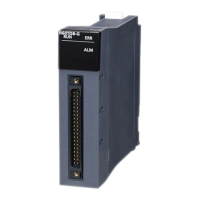196
4 OPERATION CONTROL PROGRAMS
4.14 Program Control
Selective branch control: SELECT - CASE - SEND
■Usable Data
: Usable
■Description, data type of result
• The block described between CASE and CEND is executed selectively according to the true/false of the data specified with
(S1) to (Sn).
• The true/false evaluation is carried out in order from the top, and the block described between CASE which is first
evaluated to be true and CEND is executed. After that, no true/false evaluation is carried out until SEND, and the next block
of SEND is executed.
• When the data specified with (S1) to (Sn) are all false, the block described from CELSE to CEND is executed.
• CELSE can be omitted. In that case, if the data specified with (S1) to (Sn) are all false, the block between SELECT and
SEND is not executed, and the next block of SEND is executed.
• The following number of CASE(Sn) to CEND can be written between SELECT and SEND
• Maximum multiplicities of selective branch control are eight including conditional branch control. (IF - ELSE - IEND)
Format Number of basic steps Usable steps
F/FS G
SELECT
CASE(S1) - CEND
CASE(S2) - CEND
CASE(Sn) - CEND
CELSE - CEND
SEND
SELECT: 1
CASE: 8
CEND: 5
CELSE: 1
SEND: 1
Setting
data
Usable Data
Bit
device
Word device Constant Calculation
expression
Bit
conditional
expression
Comparison
conditional
expression
16-bit
integer
type
32-bit
integer
type (L)
64-bit
floating
point
type (F)
16-bit
integer
type
(K/H)
32-bit
integer
type
(K/H, L)
64-bit
floating
point
type (K)
(S) to (Sn)
Setting data Description Data type of result
(S) to (Sn) Conditional data which controls the flow of program
CELSE Number
Not used 64
Used 63
SELECT...
SELECT...
CASE...
CEND
SEND
CASE...
CEND
SEND
IEND
IF...
(3 level) (2 level) (1 level)

